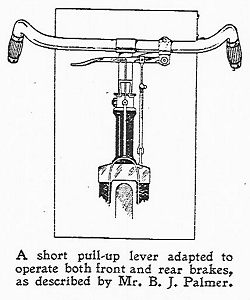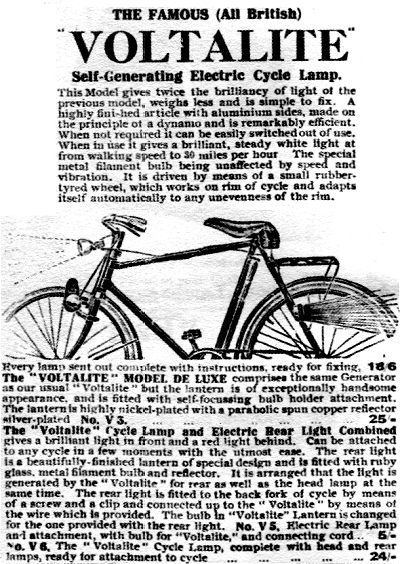 Go
to the Archive index
Go
to the Archive indexThe following tips with regard to Auto-Wheels may be of service to some of your readers. The first concerns the brakes. I found two brakes on the back wheel necessary if the front one was not to be used, so I converted my front broke as follows. The pattern fitted was a short pull-up lever. I attached a second brake to the rear wheel, leaving the original Bowden on the seat stays undisturbed, the new one being of the type that fits on the chain stays and is operated by a roller lever on the left side of the handlebar. I scrapped the roller lever, and moved the front brake lever over so that the rod that formerly entered the sliding rod of the front brake now came into the right position for that of the new rear brake. A hole was drilled in the lever at a distance further along that coincided with the old front brake rod, and a new rod turned over and riveted into this hole loosely. The one lever now applies both brakes. The front one is set some way from the rim, so that it is not applied till the last few ounces of pressure are put on. In this way one can apply ample power to the back wheel with the two brakes till the machine is nearly at a standstill, and then, if it is necessary to increase the stopping power, a little more pressure puts the front one on, thus effectually bringing the cycle to rest. The illustration makes the point clear.

Many Auto Wheelists like to travel rather further than the 50 miles which their tank takes them, but do not want to have to apply at a garage for a very small quantity of petrol - which, indeed, many garages will not supply. My plan is to purchase an empty quart Vacuum Oil tin, which a dealer will sell for a copper or two. Get this thoroughly clean by repeated washing out with petrol till it comes out quite clear. It will be necessary to cut a leather washer to form a tight joint, and you have then a beautifully made quart reserve tank, which will carry you another 20 or 25 miles if you run out of petrol anywhere. I find that the "bike bag" sold by Gamage's takes this as if it were made for it, and leaves ample room underneath for all tools and a few small spares.
If the extra expense is not too much, a good investment is a Voltalite dynamo, to drive off the front wheel. An excellent light is given both fore and aft by this little contrivance, and the elimination of all worry as to whether one's tai1 lamp is alight in a high wind is worth something. As long as the front lamp is burning, one knows that the back one is doing likewise, since the current has to pass through both and the failure of one would extinguish the other. As the Auto Wheel goes up hills. at the same pace as on the level the light is uniformly bright.

The great thing to remember with the Auto Wheel is that speed spells power, and that a touch of the pedal before the pace drops on a hill will generally save any pedalling at all for the rest of the climb. Provided the machine is put at a hill at a good speed, its climbing power is astonishing. Mine usually attracts attention by taking the hill up out of Redhill on to Earlswood Common, which most cyclists walk, quite easily. Similarly, the Queen's Road in Brighton, just past the clock tower, is steep enough for a little distance to bring all the cabs down to second gear, but my Auto Wheel takes this comfortably. I find the machine easier to handle than I can imagine the lightest motor cycle to be - in fact, its behaviour is exactly like that of the cycle to which one is so accustomed and it is perceptibly easier to hold it up in a stiff wind, owing to the greater weight on the road.
First published in Cycling, 12 August 1915